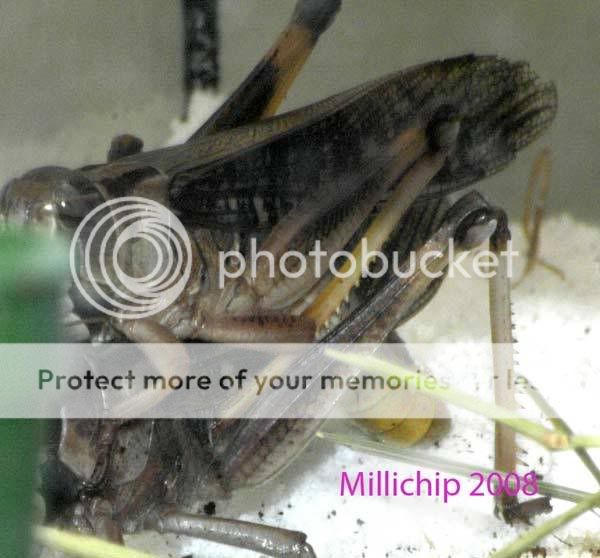Locust Keeping and Breeding.
This is a post that I originally wrote for reptile forums some years ago, but is applicable to fish keepers.
Locusts are a good challenge:
The newly hatched are good small-food;
The various instars are excellent for all sorts of herps.
Adults are an added fun for larger creatures such as larger chameleons.
They do not smell as bad as crickets
They make great pets in their own right.
They are bit more difficult to breed than, say, crickets.
It has a great deal to do with timing hormone coincidences….a bit more so than with crickets maybe?
The Tank.
I keep my breeders in an 18inch tall ExoTerra viv (it is one that I had spare).
The tank is fairly spacious, it is well ventilated with an extractor fan (from a computer) placed on top to keep the tank airy and dry. Locusts will succumb to fungal infections in damp enclosed conditions.
A heatmat on the backwall gives a minimum temp overnight. A 60 watt spotlight is placed inside and switched on during the day. This should raise the temperature to the low-to-mid 30s celcius.
There is a small scattering of coco husk on the floor.
There are stages (perches) of egg-boxes to give various sitting sites (behind the bulb-system)
Inside the tank are placed breeding sites:
I use either coffee jars filled to the brim with moist sand/coco-husk mix and topped with moist sand, or old live-food containers filled with the same mix.
Fig2. The Locust breeding tank. With heatmat (A), shallow breeding tub ( and deeper breeding tub (C).
and deeper breeding tub (C). . Staging is behind the aluminium foil divider.
The Locusts
In a bought box of 6 adult (winged) locusts, you may have males and females (statistically….hopefully).
Feed them well. They need a lot of food.
Scatter some gut-feed and bran on the ground.
Most importantly…..plenty (I mean plenty) of vegetable matter. I prefer to clippings with plenty of young shoots of grass to get the males into breeding condition. You could use cabbage (but it stinks).
Coriander stems, dandelion leaves, and sliced carrots are a good supplement.
Keep them as crowded as possible....crowding induces breeding.
Are they breeding or what?
Locusts may clamber onto each others backs anyway, but during copulation the male is on top facing the same direction as the female and he wraps his abdomen downwards and below the females abdomen (wrapped a bit like crossing your fingers), then the tip of his abdomen is raised upwards towards the females tip. (I could of though of easier ways of getting to the same position….but that is locusts for you).
fig3. Male (A) and female ( locusts about to copulate.
fig4. Close of tips of abdomens of male (A) and female (
locusts about to copulate.
fig4. Close of tips of abdomens of male (A) and female ( .
.
Now, the next bit depends upon the temperature: the female will lay the eggs in about 7 to 14 days.
I tend to give a good spraying (with luke-warm water) to the tank to help induce the egg-laying. The breeding compost needs to be moist but not soggy. You may find a solitary female laying the eggs, but I generally note that the male rides on her back (but not copulating) as she hunts for a breeding site and lays the eggs.
fig5. Female pushing abdomen into moist sand to lay eggs (in an ootheca)
She will test the surface first with the tip of her abdomen. Then, if the compost is suitable, she will push her abdomen into the compost (upto about 4inches)
The female will firstly deposit a foam-like substance into which she lays the eggs (note that whilst I am tempted to give the proper terms, I’m using layman’s terms here).
fig 5 & 6. egg deposit holes. If sand is just moist, the hole will not fill-in.
If the compost is of the correct moisture content, the hole should still be visible when the female has left. If the compost is too dry then the hole will collapse if you are using sand.
If you use glass or plastic breeding sites then you may be able to see the foam tunnel if eggs are laid close to the sides.
fig7. Foam with eggs (ootheca)
Incubate at 30-32 Celsius for 7 to 14 days. Hopefully, you should get baby hatchlings; these should be fed bran mash and grass (coriander as well).
fig 8 and 9. Young hoppers 14 days afters after laying. First food is grass.
For the keen eyed, there maybe some young crickets in there.
To recap on The Key things are:
well fed adults (male and female of course, and fed on grass shoots); heat; dampish egg-laying media; heat; and feed the young (grass clippings). Mating-to-hatching.....just over 2 weeks.
Hints to best success include......overcrowding, perches, and mimicking a bit of rain just prior to laying.
Other Notes
Locust's life-span is rather variable.
The life-span from 3 to 6 months would be a good average (but maybe upto 9/10 months....not sure what the record is though). This depends upon environmental conditions.
After hatching, it can take 1 to 2 months to reach adult hood (but may take longer). That will depend upon conditions/food.
there are more hints to manipulating the breeding that given above:
eg, If you want to increase the number of eggs layed then isolate females after copulation (I don't bother with this).
ian












